A solid content strategy is the reason for most underlying success when building up your presence online. We can recognize the following convention architecture for most websites, in this case law firms:
- Home Page
- About Us -> The Team -> The Lawyers
- Practice Areas
- Contact Us
Even these conventional “must have” pages have evolved in criteria over the years, mostly in the form of word count and some on-page best practices. Main practice area for some law firms have their word count in the thousands, covering commonly asked questions about the laws associated with their legal issue.
A website to me has always been a work in progress: if you aren’t working on user experience, you’re testing different forms of communication on the site such as SMS capabilities and chat. If you aren’t working on an ongoing blogging series, you’re adding video embeds and images to keep people on the site longer.
Even if you aren’t in the “Content is King” camp like I am, there’s no way around the fact that an ongoing content plan creates vastly more opportunities for visibility online for the numerous ways people search for legal services. I will be going over 10 different types of content you can be doing to cover all of the potential search queries people have. Most are done here and there without thinking much about it, but I’d encourage all of the following to be done consistently to some degree if possible.
1.) Granular Service Pages
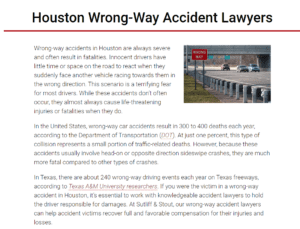 While there are few law firm websites that don’t lay out most of their practice areas with dedicated pages, very few get granular with each one. Before I proceed with how that looks, it’s important to reflect on how we set up our current practice area pages. Some people don’t refresh their auto accident, DUI, and divorce pages for years – though those are among your most important pages on your entire website. In some cases, these are the most important page on your website from an SEO standpoint. Make sure they are up to date and have more than 300 words a piece before proceeding with getting more granular.
While there are few law firm websites that don’t lay out most of their practice areas with dedicated pages, very few get granular with each one. Before I proceed with how that looks, it’s important to reflect on how we set up our current practice area pages. Some people don’t refresh their auto accident, DUI, and divorce pages for years – though those are among your most important pages on your entire website. In some cases, these are the most important page on your website from an SEO standpoint. Make sure they are up to date and have more than 300 words a piece before proceeding with getting more granular.
Once you have your main practice area pages set up to the point your competitors are marveling at your commitment to providing great legal client, we can proceed with getting granular. Let’s revisit those main practice area pages from a structural standpoint.
Smithandsmith.com/dui-lawyer/ (notice that I mostly avoid a /practice-areas/ tier. I am not completely opposed to this page, though I’d prefer to have the main practice area pages laid out on the homepage, keeping the architecture of the website a bit flatter. This is because, when we go granular, I’m going to a tier 4 with some of these practice areas, which is a bit deep for a legal website in my opinion and begins to stymie the crawling of the website you’re encouraging, for example: smithandsmith.com/practice-areas/dui-lawyer/dui-with-property-damange).
As you can see, you know where I’m getting with going granular.
Smithandsmith.com/car-accident-lawyer/rear-end-accidents/
Smithandsmith.com/car-accident-lawyer/car-accident-neck-injury/
Smithandsmith.com/car-accident-lawyer/car-accident-without-insurance/
These pages all feed into the main practice are page, having proper internal linking with anchor text that provides good SEO on your website, and the ability to capture qualified, specific traffic to your website.
2.) Case Overviews and Results
 Settlements, case results, verdicts, etc. etc. are all great and should definitely be included on the website.
Settlements, case results, verdicts, etc. etc. are all great and should definitely be included on the website.
But what about spending some time actually talking about the case? It helps to paint the picture for a potential client reading about “one million recovered!” or “case dropped!” leaving out confidential details. Consider what actually occurred that led to this favorable resolution. It gives the opportunity for a potential client to potentially relate to the circumstances, semantically use lots of great keywords describing how the law firm navigated through the unique legal situation, and creates internal linking opportunities via references to specific practice area pages (this is when your granular practice area pages will start to really click on your website).
3.) FAQ Pages
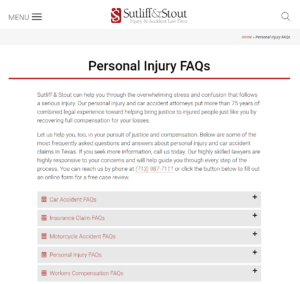 People ask millions of questions – answer them!
People ask millions of questions – answer them!
I’ve seen some of the most successful SEO campaigns on law firm websites revolve around very extensive FAQ pages dedicated to each practice area. Here, they succinctly answer not only questions that commonly come in from potential or current clients, but also other sources:
- Legal Resource websites like Avvo and Lawyers.com
- Message boards/forums like Reddit and Quora
- Social platforms like Facebook and Instagram
It is very easy to compile a list of questions and answers that are widely searched, along with producing the content for them through videos, which I would recommend since it can be repurposed into other types of content. More on that in just a minute.
4.) Geo-Specific Pages
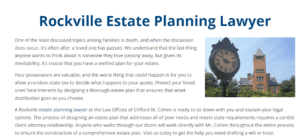 These are among my all-time favorite content opportunities, since people like to qualify their searches by geography. Law firms rarely create dedicated pages for the areas around them, which is technically the “area you serve.” If you’re in a metropolitan area, you may have clients willing to travel 10, 20, even 50 miles if they’re impressed with what they find on your website. The geo-specific content strategy is more relevant than ever as of July 15th 2020. People are hardly traveling anywhere, so as far as I’m concerned at this point, you could cater your geo strategy to the entirety of the states you’re licensed to practice in. Many consultations and sign-ups are of course remote, so as long as you’re the right fit for the client, it doesn’t make much of a difference if you’re hundreds of miles away.
These are among my all-time favorite content opportunities, since people like to qualify their searches by geography. Law firms rarely create dedicated pages for the areas around them, which is technically the “area you serve.” If you’re in a metropolitan area, you may have clients willing to travel 10, 20, even 50 miles if they’re impressed with what they find on your website. The geo-specific content strategy is more relevant than ever as of July 15th 2020. People are hardly traveling anywhere, so as far as I’m concerned at this point, you could cater your geo strategy to the entirety of the states you’re licensed to practice in. Many consultations and sign-ups are of course remote, so as long as you’re the right fit for the client, it doesn’t make much of a difference if you’re hundreds of miles away.
Typically, the geo strategy would look like what I have in the following image – take the currently gorgeous city of Seattle I reside in. If you’re a law firm downtown, there’s no reason to participate in the following examples of “areas you serve” since in any instance of physical service, you are not outside of an unreasonable region.
The cities in green would be dedicated pages I would most certainly create immediately. These are prominent cities that stand apart from the Seattle metro with substantial enough populations. You’d do this in your own region for all larger cities, unless there’s a particular reason you don’t want clientele from that area (thinking maybe bitter college rivalries here). This would receive its own subdirectory such as /locations/ or /areas-we-serve/, looking like:
Smithandsmith.com/locations/Kirkland
I try to avoid regions, counties, and states, even with larger law firms. The additional tier doesn’t do anything discernibly beneficial from a vanity standpoint or an SEO standpoint, unless you’re going to attempt to rank statewide keywords this way, like:
Smithandsmith.com/locations/florida/Orlando
And your /Florida/ page is heavily optimized itself. Normally a tough route.
After your main city pages, you can use your discretion for the smaller regions like I’ve mapped here for Shoreline, Kenmore, Bothell, and Tukwila. This is more contingent on doing some research to see if there’s search volume. Sometimes considered suburbs in this situation, residents may simply defer their searches to the metropolitan areas right off to bat, like Seattle.
Lastly, in Orange, prominent neighborhoods are sometimes worth optimizing – perhaps not in dedicated pages, but can be a dedicated neighborhood page that lists the main ones using H2 or H3 tags. In NYC for example, it shouldn’t come as a surprise that people heavily search by borough, like “Queens personal injury lawyer.” It isn’t uncommon for the searches for some boroughs like Queens and Brooklyn to have more volume than searches like NYC and New York. It also isn’t uncommon for people to search in larger neighborhoods as well – Manhattan has plenty of searches including Midtown and UES. Brooklyn with Greenpoint and Red Hook, and Queens with Astoria and Long Island City.
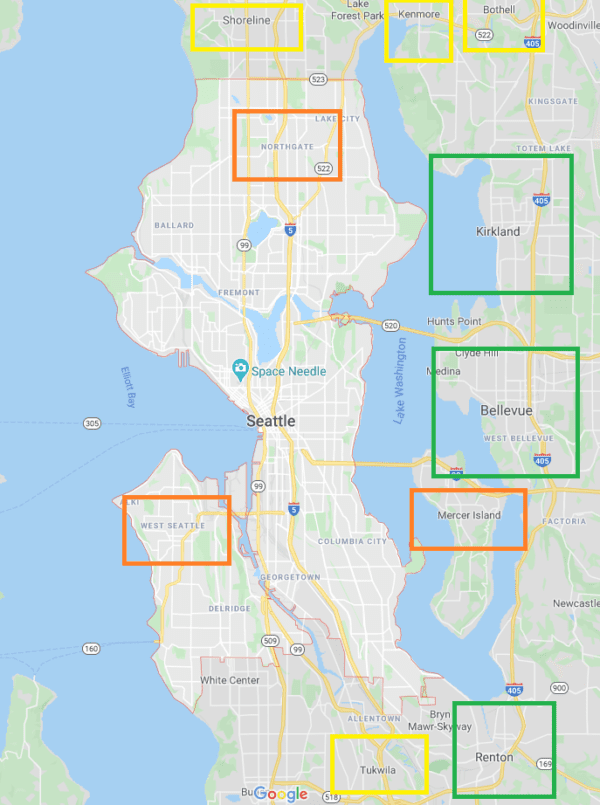
5.) Transcribed Content (Podcasts, Videos, Interviews)
We’re all about getting content any way that we can, so transcription can be a great way to make that happen. Any content being produced in a non-written format can be transcribed – the goal is to avoid having to edit errors in software transcription, so sometimes we really like using Rev.com as a go-to, that is normally handled by people attentively doing this process manually.
YouTube has come a long way in their own built-in transcriptions, which can be exported; but again, you may need to edit their transcriptions.
Here is an example: https://www.marketmymarket.com/automating-your-seo-in-2021/
6.) Long-Form Articles
Articles find the middle ground between your traditional blogs and webpages. While less casual that a blog may be, an article doesn’t fill in for any specific practice area either. Long-form articles are essentially getting as thorough as you can about a particular legal topic, providing professional insight and clarity on interpretation of laws and legal issues and how they affect everyday people.
Think about your articles establishing you as an authority – giving lucid and helpful insight that your readers can hopefully use. Typically at about 1,000 words, and not as thorough as the comprehensive eBooks we’ll talk about soon in the thousands, articles are also among the most likely to get backlinks naturally on your website (at this point, this “blog” could easily be construed as an article as well, and hopefully, will be seen as such).
As far as topics, it’s easy to think of these as your “How To” guides.
7.) Testimonials and Reviews
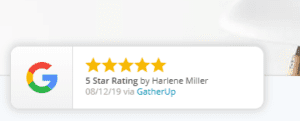 According to Nielsen, 92% of consumers trust recommendations for services from people they know, and 70% trust consumer opinions posted online. Reviews and testimonials are crucial in this day and age for helping people select your law firm. Having 5-star reviews and glowing testimonials from clients will make your law firm appear more trustworthy. What’s more? You can use these reviews and testimonials to supplement your content.
According to Nielsen, 92% of consumers trust recommendations for services from people they know, and 70% trust consumer opinions posted online. Reviews and testimonials are crucial in this day and age for helping people select your law firm. Having 5-star reviews and glowing testimonials from clients will make your law firm appear more trustworthy. What’s more? You can use these reviews and testimonials to supplement your content.
Using excerpts from testimonials and positive reviews can help you write more effective calls-to-action in your blogs and other types of content. Featuring reviews and testimonials on your website in a footer or sidebar can also reassure whoever visits that you’re a trusted and reliable provider of the service they’re researching. Additionally, you can use testimonials and reviews as part of case studies. A case study is a highly-effective tool to display results you have achieved for past clients. You can view examples of some of our own case studies here.
8.) Blogs That Cover Long-Tailed Keywords
 Long-tailed keywords are more specific than general searches and seek to get more detailed answers about a particular topic. When you write blogs that address long-tailed keywords, it’s essentially like dedicating an entire post to answering one frequently asked question. Ultimately, the goal is to provide as much information as you can about the topic, and answering the “Who, What, Where, When, Why, and How?”
Long-tailed keywords are more specific than general searches and seek to get more detailed answers about a particular topic. When you write blogs that address long-tailed keywords, it’s essentially like dedicating an entire post to answering one frequently asked question. Ultimately, the goal is to provide as much information as you can about the topic, and answering the “Who, What, Where, When, Why, and How?”
For example, a person who searches for information about a new law or changes to an existing law could come across a blog you wrote explaining your interpretation of the new law or updates. If you’re not sure about how to write these types of blogs, you can type in a general question you get often and look at the related searches at the bottom of the results. You can find a surprising number of topics this way!
9.) Checklists and Tutorials
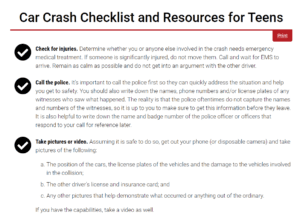 Checklists and tutorials are a great way to help potential clients understand what they need to do to resolve their particular legal situation. You can write checklists about steps to take after a car accident, criteria for finding a good lawyer, and reasons to consider hiring a lawyer in the first place. Effective tutorials also provide information about what a person can do without a lawyer to achieve a particular goal. For example, you could write a tutorial about how to restore your gun rights or seek an expungement.
Checklists and tutorials are a great way to help potential clients understand what they need to do to resolve their particular legal situation. You can write checklists about steps to take after a car accident, criteria for finding a good lawyer, and reasons to consider hiring a lawyer in the first place. Effective tutorials also provide information about what a person can do without a lawyer to achieve a particular goal. For example, you could write a tutorial about how to restore your gun rights or seek an expungement.
Paired with attractive graphics, a checklist or tutorial can engage potential clients and provide an opportunity to highlight your expertise. Working with a graphic designer to create infographics will enhance the content, making it more likely that readers will absorb the information presented and share it. You could also create video clips for your most-read tutorials that people can view on social media.
10.) Ebooks
Putting together an ebook can seem like a monumental task, and in some ways, it can be. Ebooks are useful for promotional purposes and are a great way to collect all the information you’ve written about for one topic in one place. Someone who is interested in a particular topic, like DUI or divorce, can download your ebook that contains all your knowledge and expertise on the subject. Often, ebooks are offered for free or at a discount as a way to get people to learn about your firm and potentially work with you in the future.
Ebooks are provided as PDFs, and they are indexed by Google and crawled as well as any other types of content. Overall, this is a much more time-consuming type of content you could work on when you’re interested in promoting a particular service; however, an ebook is still an effective way to connect with potential clients.
You can view Market My Market’s recent Ebook here.
Diversify Your Content Marketing
The possibilities for creating useful and engaging content are nearly endless. There are so many different formats in which you can present your content, that sitting down to write even one really good piece is never a waste of time. However, if you’re finding it difficult to make time to write quality content, and aren’t sure which types of content will be most effective for your law firm, you’ve come to the right place. Find out how Market My Market’s legal marketing agency experts can implement the above strategies to enrich your website’s user experience with a free marketing consultation .

MMM Author Ryan Klein
The ongoing digital revolution is transforming the way that all businesses interact with clients and customers. Consumers rely heavily on digital channels for researching products and services and expect to make buying choices with the swipe of a finger. For organizations that want to remain competitive, having a defined digital marketing strategy and execution plan is essential for successful outcomes. With a demonstrated history of creating and implementing strategic digital marketing initiatives that drive growth, I am committed to delivering real, measurable results for my clients.
